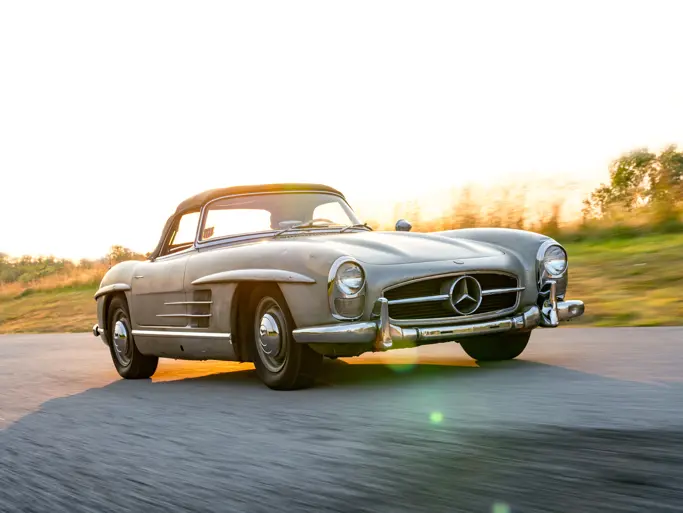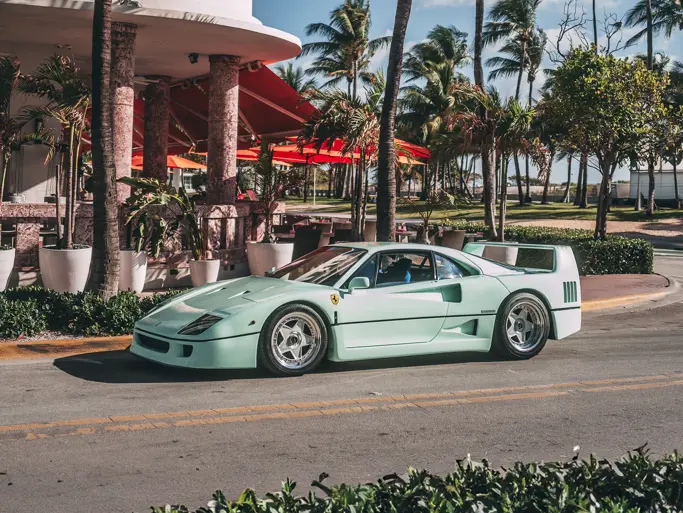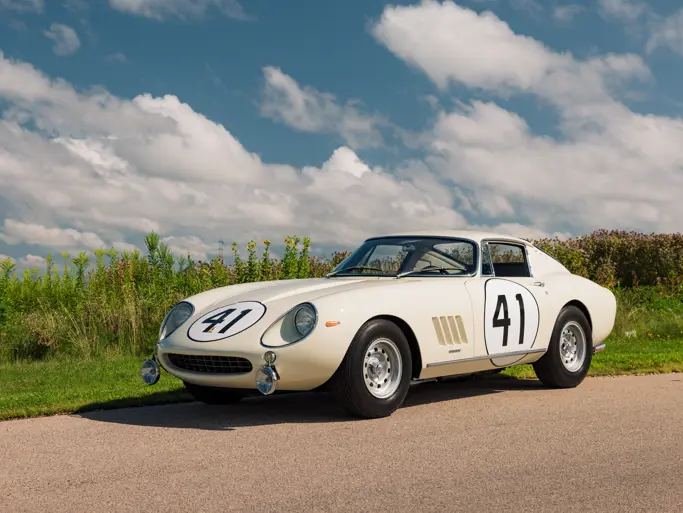Monterey is no normal auction, with this year’s offering numbering more than 200 collector cars with a cumulative lower estimate in excess of $210,000,000, so it only seems fair that we up the usual budget for this special edition of The Fantasy Garage. As a man with expensive taste, we loosened the purse strings to give RM Sotheby’s Director of Research, Michael Squire, a budget of $25,000,000 with which to fill his seven-space fantasy garage. Here’s what he chose.
2001 Bentley Continental R Le Mans
“Twenty-five million dollars is an awful lot of money, but this year’s Monterey sale has so many tempting ways to spend it. For that reason, I’ve started off small with my fantasy garage—at least in terms of outright price. Value is a completely different matter, and while it’s likely this 2001 Bentley Continental R Le Mans will go for less than $100,000, it surely presents the best value on the Monterey Peninsula this August.
“The Bentley Continental R was already the height of luxury in the late 1990s and early 2000s, and the Le Mans edition, built to celebrate the firm’s return to the Circuit de la Sarthe in 2001, only made it more appealing thanks to wider, more purposeful wheel arches, quad tailpipes, and a number of other subtle design features.
“Bentley only made 46 of these cars, and just 15 were finished in left-hand drive like this one. It’s just the fifth built by serial number and has lived a quiet life, with just 8,559 miles on the clock. Considering the original sticker price, this beautifully specified Continental R has to be one of the best value offerings of Car Week and I’d be mad not to put it in my garage—even with $24,900,000 spare change.”
1964 Sunbeam Tiger "Monster" Racecar
“I’ve always been a big fan of the Sunbeam Tiger—it’s such a charismatic car, benefitting from classic British styling and good old American V-8 power. They’re also a real pleasure to drive quickly, having raced a Le Mans coupe myself for several years.
“This particular car is very special and was raced with great success in the United Kingdom by Bernard Unett,” explains Squire. “It was built with a number of competition components borrowed from the 1964 24 Hours of Le Mans Lister Tiger coupe including its aluminum doors and bonnet, with Dunlop magnesium wheels sitting under enormous flared arches, while power came via a small-block 289-cubic-inch V-8.
“The Monster isn’t just a unique piece of racing history, it’s also incredible value when you compare it to other big-engined GT cars of the 1960s.”
1993 Cizeta V16T
“I tend to prefer my cars a little older than this, but the back story to the Cizeta V16T and the ambition surrounding its creation is just too fantastic not to appreciate,” says Squire. “So many valiant attempts have been made over the years to create a supercar from scratch, outside of the sphere of the big manufacturers, but too often they ended in failure. The Cizeta V16T was one of the few to succeed—even if only nine cars were made.
“Unlike other boutique supercars that often relied on chassis and engine combinations borrowed from existing cars, the Cizeta was a creation all its own,” explains Squire. “It’s one of the very few cars of the modern era to feature a V-16 engine, which is more often seen in pre-war American Classics. The styling, too, was absolutely wild, and must rank among Marcello Gandini’s most striking works.
“The best part of the Cizeta V16T is the back story, with the project initially being funded by music mogul Giorgio Moroder before three cars—this being the first—were sold to the Brunei Royal Family. It’s got stiff competition, but this has to be one of the most interesting cars to come out of the early nineties.”
1957 Mercedes-Benz 300 SL Roadster
“The Mercedes-Benz 300 SL Roadster is a stalwart of the collector car scene and with good reason, but so many great cars over the years have fallen victim to over-restoration, erasing their history and making them practically indistinguishable from the next car,” explains Squire. “This car is the antithesis, and for that I absolutely adore it.
“The Mercedes was bought new by a USAC team owner named Douglas Stearly, and in his stewardship, it became one of a vanishingly small number of 300 SL Roadsters to compete in an international race when it lined up against the competition at Nassau Speed Week in 1958.
“Period race history makes this Roadster a fascinating proposition, but even more enticing is its fabulous, unrestored condition,” enthuses Squire. “Stearly kept the car for 50 years, and subsequent owners thankfully resisted the urge to carry out a restoration. Today it wears its original Silver-Grey Metallic paint and red leather upholstery, as well as retaining its matching-numbers engine, chassis, gearbox, body, rear axle, and even five original wheels.
“Auctioneers often speak of ‘unrepeatable opportunities’, but this one truly is. Perfect for the preservation classes at top concours, it would take the fourth space in my fantasy garage.”
1991 Ferrari F40 ‘Minty Forty’
“The Ferrari F40 is one of those cars that made a lasting impression on me as a child, and nothing has changed in the intervening years. It’s a landmark model that’s instantly recognizable to everyone and is more than deserving of a place in any collection. But it’s first and foremost a driver’s car, and too often low-mileage examples are consigned to a dull existence in climate-controlled purgatory.
“This car is the total antithesis of a low-mileage trailer queen and while I’m usually a stickler for originality, I can’t help but fall for this unique example. Much of that appeal is down to its unorthodox repaint in mint green—or Verde Pallido—the very same shade that adorned the 250 GTO built for Stirling Moss and campaigned at the 1962 24 Hours of Le Mans by Innes Ireland and Masten Gregory.
“The Minty Forty has become something of an internet sensation in recent years, and it’s easy to see why. It reminds us all that, first and foremost, cars should be fun.”
1967 Ferrari 275 GTB/4 NART Alloy by Scaglietti
“Leonardo Fioravanti may have found the 275 GTB/4 rather old fashioned, but to me, the design is the perfect combination of beautiful design and performance,” explains Squire. “It’s a car with real purpose—a sublime grand tourer with true competition pedigree. A large part of that legend is due to this specific car, which became the only four-cam to achieve a class victory at an international race when it romped home in the 1969 24 Hours of Daytona. Quite simply, this car is one of the greatest four-cams in existence.
“In addition to its incredible period history, having been prepared for competition by Luigi Chinetti’s North American Racing Team and scoring that famous win with Sam Posey and Riccardo Rodriguez, it also sports a fabulous original color combination and retains its matching-numbers engine and gearbox—impressive for a racing car of this vintage. It’s also comparatively good value against other significant 250 and 275 competition cars.
“Top collectors are always drawn to the very best examples, and I suspect I would have some competition when this stunning car crosses the block.”
1955 Ferrari 410 Sport Spider by Scaglietti
“There’s one car more than any other that would have me reaching for my checkbook, and it’s this 1955 Ferrari 410 Sport Spider. The 410 Sport is arguably the greatest of Ferrari’s front-engined V-12 sportscars, and this example is particularly interesting. It wears stunning and totally unique coachwork by Scaglietti and served as the prototype for the two cars that would follow.
“The 410 Sport Spider may not have raced at the Carrera Panamericana for which it was conceived, but it did lead an interesting early life and won at Palm Springs in 1956 with none other than Carroll Shelby. And the story only got more intriguing from there.
“The car was the last ever Ferrari to be acquired by Tony Parravano, the Southern California racer and property developer who famously disappeared just weeks after the 1956 Palm Springs Road Races. Parravano fled to Mexico in the face of mounting tax problems, taking the 410 Sport Spider with him. He eventually disappeared for good two years later, just before an important court date, and was never heard from again. What happened to him remains one of the great mysteries in motorsport.
“The 410 Sport Spider is nothing short of a factory-built hot rod,” explains Squire. “For me, race cars should sound incredible and scare you slightly—and this car would do both perfectly.”









